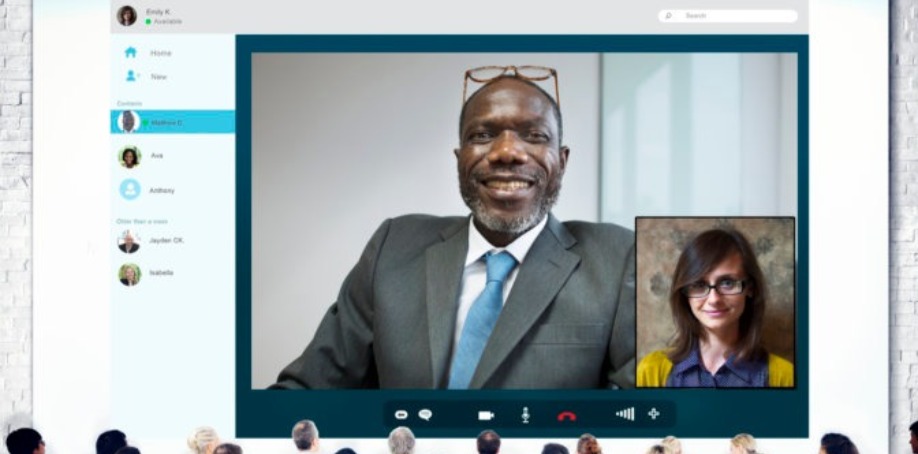
Where do your employees work? Chances are at least some work from home. Armed with the right technology, those workers could be productive, long-term members of your team.
"If you offer workers the chance to work where they need to be, and not where they are told to go to, it completely transforms their view of the company—they are more productive,” says Mark Dixon, founder and CEO of workspace solutions provider IWG. The increased productivity claim isn't just Dixon's opinion; it's backed by research.
Stanford professor of economics Nick Bloom conducted a two-year study of 500 employees: one group worked at the office; the other from home. The productivity increase of 13 percent is equivalent to nearly a full day's work each week plus “employee attrition decreased by 50 percent among the telecommuters, they took shorter breaks, had fewer sick days, and took less time off.”
To perform at peak capacity, your workers rely on your company's technology. And as video plays an increasing role in everyday business practices, companies must prepare for huge data loads and the expectation of instantaneous transmission.
Enter AV over IP.
The Role of AVoIP
Our grandparents never saw the remote work revolution coming. To them, work was something done outside of the home. Advancements in computers, the proliferation of public WiFi, and cloud-based programming changed all that, writes the team at We Work Remotely. Workers were freed from one physical location. AVoIP could be part of the next wave of change.
AVoIP is scalable, so it's easy for companies to add power when needed. And, as Paul Bray writes for AV Magazine, the technology removes noise, static and hum that can interfere with a clear video experience.
The result is a fast and clear video connection. That could help remote workers feel like they're inside of the office, even when they are miles (or continents) away.
Current Video Usage for Remote Workers
Companies aren't waiting for the future to arrive. Plenty are already using video to help keep their remote workers engaged and supervised.
Tech writer Simone Stolzoff advocates for video-only meetings, even when all participants are in the office. The model allows for quick research, link sharing and increased collaboration, he says.
An AVoIP system could accommodate that traffic, as anyone with access to the network could tap into the power. Video meetings could be so efficient that they could replace the conference call.
"In my experience, one-third to one-half of the time spent on a conference call is wasted on refocusing a meandering discussion, clarifying misunderstandings because someone wasn't paying attention, and reviewing topics already covered. This doesn't happen in videoconferences," writes executive advisor and co-author of “The Hidden Leader,” Scott Edinger.

Video Best Practices
With an AVoIP system installed, companies could hold more and more meetings online with a video component. It pays to ensure that these meetings run as efficiently as they can.
Doist, a company that creates tools for offsite workers, recommends introducing remote-first meeting procedures. Encourage all workers to conduct meetings via video, so those online don't feel at a disadvantage when compared to those in the room. Rules like this can help ensure big meetings are optimized for video. But even small, one-on-one meetings might work a little better with a visual component.
A study from Gallup suggests that remote workers are 30 percent less likely than in-office workers to strongly agree that they have talked with a manager about goal setting within the last six months. "It's not as easy for managers to stop these employees in the hallway to see how their days are going, give feedback or ask how they are progressing on projects. Without this constant contact, managers are faltering on providing fundamental development opportunities—and perhaps increasing the risk that their fully remote employees will leave for better opportunities with other companies," Nate Dvorak and Junko Sasaki write for Gallup.
A quick check-in via video call could help those employers stay in contact with their workers. These talks aren't precisely the same as a hallway conversation, but for some workers, it could be just what's needed.
Some employers might mandate these calls, especially for new hires.
In an article for Harvard Business Review, Raj Choudhury, Barbara Z. Larson and Cirrus Foroughi discussed their findings regarding remote work. They focused on a company that required multiple supervisor approvals, especially for new employees. Their study found that when the employer mandated the use of the common IT tools (e.g., VPN and messaging) by early-career work-from-anywhere employees, who needed more approvals from their supervisors, those employees realized an additional 3 percent increase in productivity.
Your office may not have the same official requirements for approvals and check ins. But studies like this suggest that mandating the use of technology can help remote workers stay connected.

What Does the Future Hold?
Workers can use video now, and in some cases, are required to hold meetings via video connection. In the future, they might use the technology to do a whole lot more.
"If someone local is unavailable or out of the office, you attribute it to the situation, that something must have come up. If someone remote is unavailable, you attribute it to the personality, that they are shirking, avoiding you or are incompetent," according to researcher Judith S. Olson, Ph.D., author of the textbooks “Working Together Apart” and “Enhancing the Effectiveness of Team Science.”
A quick video connection could let workers see one another in real time, making those assumptions harder to form. Some companies take the concept yet further. "There have even been jokes about getting a robot with a screen on it, so people can call in and zip around the office and see everyone," says entrepreneur and business consultant Samantha Radocchia.
It may sound futuristic, but it's a reality for some companies.
Will Yakowicz at Inc. profiled a 13-person, all-remote Shutterstock team that stays connected via video chat all day long. Each person on the team has a modified iPad with a wide-angle lens, and as that person works, the camera captures everything.
A commitment to around-the-clock video communication could conquer one of the most persistent complaints regarding remote workers.
"The only frustration I have around communication is when a coworker is unresponsive on those channels. When I was in the office, I could simply visit that individual's desk and see them in person. But it's quite difficult to get those direct answers if they're uncommunicative via digital channels," says Ciara Hautau, lead digital marketing strategist at technology consultancy Fueled.
If every teammate commits to staying on camera all day, a quick glance at the screen could tell you whether someone is on the phone, eating lunch or simply ignoring the outreach. A dip in misunderstandings could follow.
While staying on camera all day requires significant bandwidth, AVoIP could make it not only possible, but likely.
An AVoIP Investment Could Help Your Team
Remote work comes with tangible benefits. Petsitters become obsolete, commutes disappear, and work/life balance is easier to achieve. But working from home also comes with drawbacks that video could amend.
"Offices provide an environment for collaboration, teamwork and plain old human contact that is an invaluable part of a successful company. I know that not having that environment means I'm missing out on identifying potential opportunities or solutions to problems that naturally come about during office conversations—even if most of these conversations are about The Bachelor," writes columnist Gene Marks.
Collaboration and remote work don't need to be mutually exclusive. If teammates can both see and hear one another regularly, they can trade ideas just as freely as they might in a shared workspace. But technology is key.
Adam Hickman, Ph.D., content manager for Gallup, explains that loneliness, which 21 percent of remote workers call their “biggest struggle,” is different than isolation. "Isolation...is related to access—or lack of it. The isolated can't get the materials or information they need, they think their achievements or development are ignored, they feel cut off from the business. That isn't an emotional issue, it's a technical one."
If remote workers can't get the approvals, feedback and data they need to do their work, they're not likely to stay with the company. If they do stay, they may not be engaged or contributing at peak levels.
An investment in AVoIP could also ensure that your workers take advantage of vacation opportunities—which is an important burnout-prevention tool. A Buffer survey of nearly 2,500 remote workers found that only 7 percent said taking a vacation was a struggle. The flexibility of a robust system could allow these workers to stay connected even as they travel, so they don't need to block out huge chunks of time to get away from the office.
A system with AVoIP capabilities could be just what these workers need to take the time they deserve and are entitled to, without losing a moment of productivity.
Images by: rawpixel/©123RF.com, fizkes/©123RF.com, jovanmandic/©123RF.com


